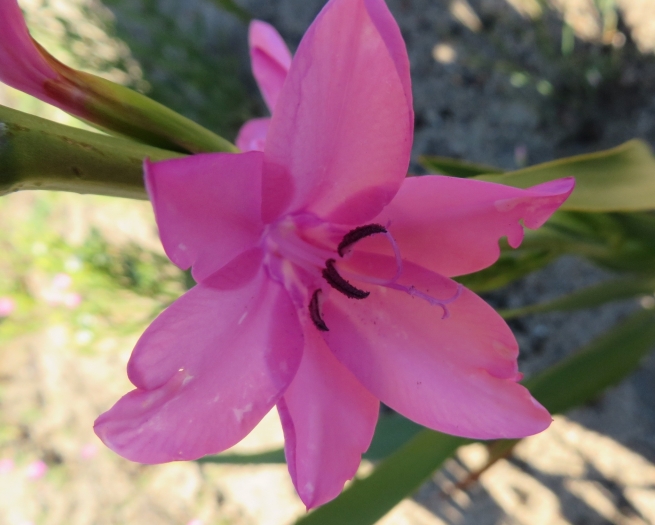Cape Bugle-Lily
(Watsonia borbonica)
Cape Bugle-Lily (Watsonia borbonica)
/
/

linkie
CC BY 4.0
Image By:
linkie
Recorded By:
Copyright:
CC BY 4.0
Copyright Notice:
Photo by: linkie | License Type: CC BY 4.0 | License URL: http://creativecommons.org/licenses/by/4.0/ | Rights Holder: linkie | Publisher: iNaturalist | Date Created: 2017-09-09T11:20:18-07:00 |

























Estimated Native Range
Summary
Watsonia borbonica, commonly known as Cape Bugle-lily, is a perennial herb native to the fynbos and renosterveld vegetation of South Africa’s Western Cape, where it thrives on rocky sandstone, clay, and granite slopes in winter-rainfall areas. This species typically reaches up to 6 feet (1.8 meters) in height and features sword-shaped leaves and tall spikes of trumpet-shaped flowers, which can vary in color from pink to red or orange, blooming from late spring to early summer. The flowers are showy and make an attractive display when planted in mass.
Cape Bugle-lily is valued for its striking vertical form and vibrant flowers, which add a burst of color to the garden. It is commonly used in borders, as an accent plant, or in mass plantings for a dramatic effect. In cultivation, Watsonia borbonica requires well-drained soil, moderate water during its growth period, and full sun to light shade. It is relatively low maintenance, but it should be protected from frost. After flowering, the foliage dies back, and the plant remains dormant until the next growing season. It is important to note that Watsonia borbonica can be potentially invasive in some regions, so it is essential to check local regulations before planting.CC BY-SA 4.0
Cape Bugle-lily is valued for its striking vertical form and vibrant flowers, which add a burst of color to the garden. It is commonly used in borders, as an accent plant, or in mass plantings for a dramatic effect. In cultivation, Watsonia borbonica requires well-drained soil, moderate water during its growth period, and full sun to light shade. It is relatively low maintenance, but it should be protected from frost. After flowering, the foliage dies back, and the plant remains dormant until the next growing season. It is important to note that Watsonia borbonica can be potentially invasive in some regions, so it is essential to check local regulations before planting.CC BY-SA 4.0
Plant Description
- Plant Type: Herb
- Height: 3-5 feet
- Width: 2-3 feet
- Growth Rate: Moderate
- Flower Color: Pink, Red
- Flowering Season: Spring, Summer
- Leaf Retention: Deciduous
Growth Requirements
- Sun: Full Sun
- Water: Medium
- Drainage: Fast, Medium
Common Uses
Bird Garden, Border Plant, Low Maintenance, Potted Plant
Natural Habitat
Native to the fynbos and renosterveld vegetation of South Africa’s Western Cape
Other Names
Common Names: Cape-lily, Cape Bugle-Lily, Rosy Watsonia, Pink Watsonia
Scientific Names: , Watsonia borbonica, Gladiolus pyramidalis, Lomenia borbonica, Watsonia rosea,
GBIF Accepted Name: